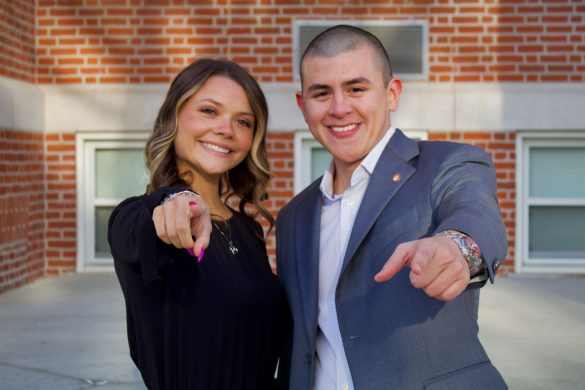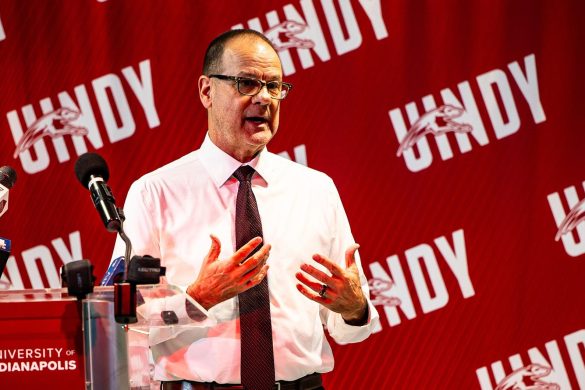Recently, legislation in California was passed that allows NCAA athletes to be paid. Two reporters discuss the implications of payment for all athletes if the same laws were passed elsewhere.

Argument for Paying Student-Athletes
Student-athletes at the Division I and Division II level deserve the right to be able to use their own image to their advantage. The way it currently stands is that all student-athletes at the D1 and D2 level must obtain an “amateurism certificate” from the National Collegiate Athletic Association before they are able to compete, according to the NCAA’s website.
This agreement requires student-athletes to give up any opportunity at benefiting monetarily from their own image while enrolled and participating in athletics at a university. According to the same amateurism page on NCAA.org, if an athlete receives payment of any kind for their sport, whether it be directly from the school, winning a competition, or even being paid for their autograph, the NCAA can revoke that players eligibility. There is an exception to this rule for tennis players who can accept up to $10,000 a year in prize money if they compete in professional competitions.
Professional athletics is one of the most profitable businesses out there, and collegiate athletics is no different with the NCAA reporting one billion dollars in revenue in the 2016-2017 academic year, according to Sports Illustrated. However, they are a non-profit organization so all of the revenue they bring in is given back into programs and other operations of the NCAA. The only difference is that instead of the players being paid for their talent and dedication to their craft, they are told that they must play for the love of the game.
Many athletes dream from a young age of being the next LeBron James, Mike Trout or Aaron Rodgers, and almost none of them will ever reach that level. According to the NCAA, where there are 300,000 student-athletes at the D1 and D2 levels combined and yet only two percent of those athletes will ever reach the level where they can be paid for their craft. However, that craft is exactly what brings in one billion dollars in revenue for the NCAA, according to Sports Illustrated’s article “NCAA Reports $1.1 Billion In Revenues.” Of that one billion dollars in revenue, more than 10 million is given back to athletes in the form of scholarships, according to NCAA.org.
The schools pay the players in the form of scholarships to play, but that only covers tuition, meal plans and books. That does not cover the cost of life. If a non-student-athlete needs money he or she can go get a job, but for many student-athletes, that is simply not possible with their busy schedules. Between practices, weightlifting, games, studying, going to classes and the many other responsibilities of a student-athlete, they simply do not have the time to work. That is why student-athletes should be able to use their image to their own advantage.
If a college athlete wants to sign a Nike shoe deal, they should be able to. If they want to allow Puma to sell shirts with their name on it and give them some of the profits, they should be able to. The NCAA should not be able to control what student-athletes can and cannot do with their own image. Brand deals can bring some negatives, but those negatives are something that the student can avoid. If a student believes they cannot handle the stress of being sponsored, they can simply refuse the money. The NCAA rules should not limit the athlete’s choice.
These ideas are already being implemented in California with their Fair Play to Pay Act. Starting in 2023, athletes will be able to be paid for the use of their name, likeness and image, according to a Sports Illustrated article “Richard Sherman on Fair to Play Act: ‘I Hope it Destroys the NCAA’.”
According to a study done by CBS Sports where they interviewed more than 100 college coaches, 77 percent of the coaches agreed that students should be able to use their own images. In this system, players would have the freedom to accept or decline any endorsement or business opportunity that uses their image. This system would not negatively affect schools unless they decide to not do it. I think that this system only brings benefits because it can increase the quality of life for student-athletes.
Student-athletes should be able to use their own image to their advantage. The NCAA won’t see major changes, the colleges won’t see major changes and the athletes will benefit.
By Jacob Walton | Sports Editor
Argument Against Paying Student-Athletes
As a student-athlete at the University of Indianapolis, I spend multiple hours a week dedicated to my sport, and I do not think that student-athletes should be paid.
At the Division I and Division II levels, student-athletes can earn scholarships that pay for their tuition, housing, meals and books. Having part or all of tuition paid for each year makes a big impact on costs for a student. College is expensive, and UIndy is almost $30,000 in tuition alone.
Having part or all of that paid for is a tremendous burden off of a student-athlete’s shoulders. Plus scholarships are tax free. If athletes were given a salary, they would have to pay taxes on it. Recently, the state of California passed the Fair Pay to Play Act. This act allows college athletes to be compensated for the commercial use of their name, according to si.com.
According to the NCAA Rules and Regulation Handbook, student-athletes may not be involved in any form of commercial endorsements. This, too, would create issues, because it comes with an immense amount of stress. Many athletes who are endorsed or have sponsorships are professionals. They are out of school and do not have the stress of college weighing on them. If student-athletes were allowed to accept these kinds of deals, that would only add more stress to our already stressful lives.
After signing a brand endorsement, the athlete becomes the face of the brand and must maintain a positive image. Many athletes get themselves into trouble with their brands because they do not uphold that image.
According to Yahoo Finance, many professional athletes have lost their endorsement deals. Most recently, former wide receiver Antonio Brown lost his Nike sponsorship after a sexual assault lawsuit was filed against him, according to The New York Times’ article, “Nike Drops Antonio Brown Amid Sexual Assault Lawsuit.”
My point is that if a professional athlete is irresponsible enough to lose his or her endorsement or sponsorship deal, imagine what a student in college would do.
Student-athletes, including me, are playing sports to get an education and help pay for that education. We also love what we do. At least that’s why I am here. As part of the track and field team, I love high jumping and being on the team, but I am here for an education in preparation for what I’ll be doing after graduation, which will not be playing for a professional sports team.
Granted, not every athlete has all tuition, room and board and books covered- or even covered partially- and I understand that. Not every student-athlete is on scholarship. That would not be realistic. Each team and head coach has a yearly budget for scholarships, travel expenses, gear or whatever else the team might need.
With 100 athletes, the track and field team has more people in its lineup than any other team at UIndy. A program’s budget simply would not allow every person to be on scholarship. Smaller programs do not have the budget to pay all student athletes. In fact, schools in Division III of the NCAA cannot even be awarded athletic scholarships, according to the NCAA’s website. However they athletes can receive academic scholarships.
If student-athletes were paid, deciding pay levels and who would pay them also would cause issues. Issues related to pay amounts would arise immediately. I think deciding salaries would be one of the largest obstacles if student athletes were paid. Differentiating pay levels among teams and players could be a serious struggle and genuinely make a lot of people angry.
Surely, not everyone would get paid the same amount. The star quarterback and someone on the soccer reserve team would not make the same amount. While paying everyone equally would be great, realistically that would not be the case, which would bring jealousy and envy and other unwanted problems.
As I said before, the main reason a student-athlete is in college should be to get an education. Handing checks to student-athletes may make them feel less obligated to go to class because they are getting paid to play their sport. Personally, if I were receiving a check every week to run and jump over a bar, I might think a lot less about classes.
I understand that being a broke college student and an athlete is tough, but having a passion for a sport makes that worthwhile. Enjoying whatever one is doing makes life more enjoyable. I would not be high jumping if I weren’t having any fun.
If student-athletes were paid, I would be curious as to the rules and regulations that would have to be put in place in regards to NCAA division and small-programs. I think there would have to be many regulations implemented.
For example, who would handle the money, how and when would checks be distributed, and how much money would student-athletes be allowed to make? With such rules and regulations would come a hefty amount of paperwork that no one wants to fill out.
Would the NCAA regulate pay for the athletes or would that be up to each university? Certainly collegiate athletics is a business, but paying student-athletes would exacerbate that and be harmful to student-athletes. Too many entanglements would arise if student-athletes were paid.
While I would love to get paid for playing a sport, paying student-athletes is not as simple as just handing over a check. Many issues arise, and there are a lot more drawbacks than benefits.








